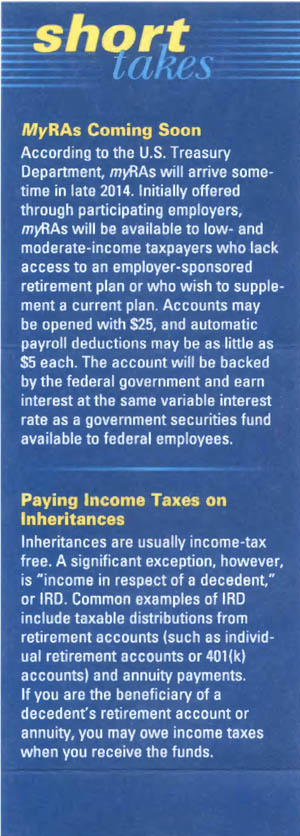Taking 529 Plan Withdrawals


To make the most of your Section 529 college savings plan, consider the following.
Qualified expenses. Withdrawals from a 529 college savings plan are tax free, provided the withdrawals are not more than the account beneficiary's qualified higher education expenses for the year. Qualified expenses include tuition, fees, books, supplies, and equipment require( I for enrollment or attendance and room and hoard for students who are enrolled at least half-time.
Don't waste your tax credit. Be careful when withdrawing money from the 529 plan if you also qualify for the American Opportunity Tax Credit-* For 2014, this credit is equal to 100% of the first $2,000 of qualifying expenses (generally, tuition and lees) and 25% of the next $2,000, for a total credit against Your tax bill of up to $2,500. However,you cannot "double dip" that is, you can't take the credit for the same education expenses you paid with money withdrawn from the 529 plan. For this reason, you might consider paying the first $4,000 of your child's college tuition with your own money and paying the balance of your child's qualified higher education expenses with distributions from the 529 plan. That way, you may use both the American Opportunity Tax Credit and the income exclusion for qualified 529 plan distributions. •
In 2014, the credit phases out rapidly for taxpaver with modified gross income of $80,000 to $90,000 ($160,000 to $180,000 for married taxpayers filing jointly).
S Corporation Basics
The way a business is structured is important for both legal and tax purposes. An S corporation has several tax attributes that a prospective business owner might want to consider.
Income
For federal income tax purposes, S corporations function much like partner ships. Generally, the items of income are "passed through" to the individual shareholders, who then account for these items on their individual tax returns.
By recognizing income only once -- at the individual level the owner of the S corporation has a potential advantage over the owner of a regular C corporation. The income of a C corporation is taxed at the corporate level and at the individual level when dividends are distributed.
Losses

Another advantage of an S corporation is the ability to pass through start-up losses to the individual shareholder. If the owner expects that the business will incur losses during its beginning phase, structuring the business as an S corporation would allow those initial losses to he used to offset the owner's other personal income.
However, the ability to take losses is subject to three limitations. First, deductions are limited to the individual shareholder's basis iii flit' S corporation stock (anti in any loans the shareholder has made to the corporation). Generally, basis begins with the cost of the shares and then is adjusted for items passed through to the shareholder for tax purposes and for distributions to the shareholder that are not included in the shareholder's income.
Second, the shareholder is unable to deduct any losses that exceed the amount that he or she has "at risk."
Third, the shareholder must "materially participate" in the business. Otherwise, any losses may he deducted only against passive activity income.
Please contact us if you are interested in discussing S corporations in more detail. 0
The general information in this publication is not intended to be nor should it be treated as tax, legal, or accounting advice. Additional issues could exist that would affect the tax treatment of a specific transaction and, therefore, taxpayers should seek advice from an independent tax advisor based on their particular circum
2014 May Pg 02


